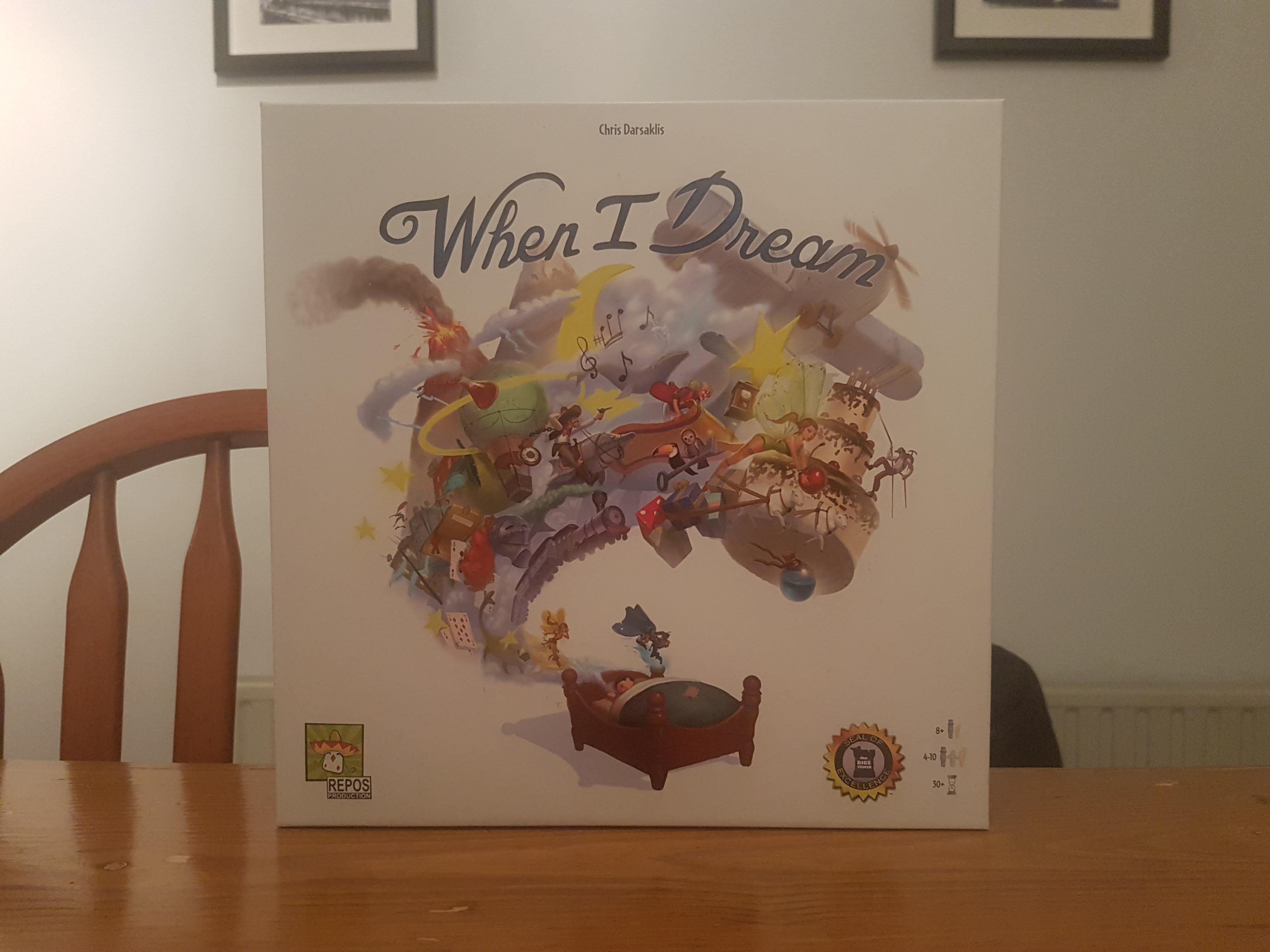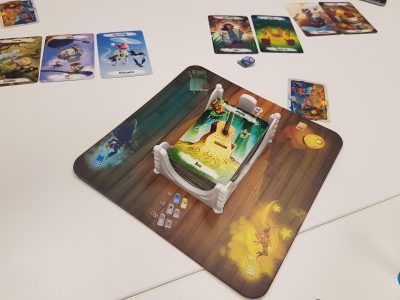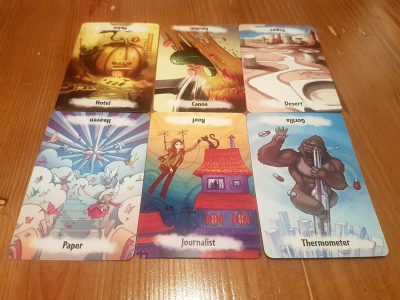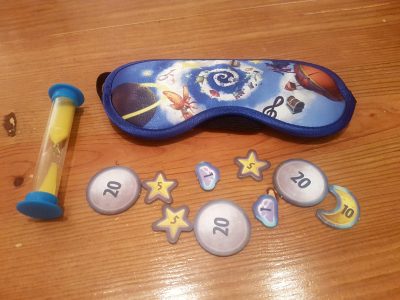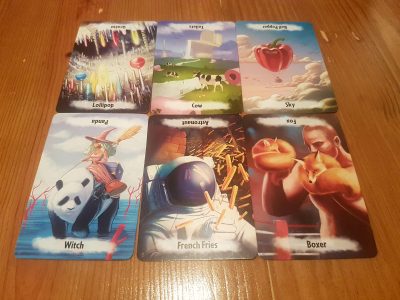When I Dream is a word and memory based party game from publisher Repos Production, which can feature elements of deduction, deception and storytelling. Designed by Chris Darsaklis, the game sees 4 – 10 players take it in turns to dream weird and wonderful things. While in this dream state spirits will try to convey elements of the dream via clues. However, is When I Dream fun to play or a nightmare? Let’s find out!
When I Dream is played out over a number of rounds. To start each round off the Dreamer is chosen and role cards are shuffled and distributed. The three spirit roles include a good fairy, a bad Boogeymen and a neutral sandman. The ratios of the roles is dictated by the player count, with a helpful table in the rulebook. Each player will get a chance to be the Dreamer once, with each round split into two parts: Night, where words are guessed, and Day, when dreams are recounted and points awarded.
As the rest of the players peak at their role for the round, as to not give away what they are, the Dreamer closes their eyes or puts on a mask. During the Night phase of a round the spirits, in turn, give single word clues to the Dreamer based off illustrated Element cards. With words such as Elf, Helicopter or Toilet it isn’t just about guessing based of all the spirit clues: as mentioned, not all spirits are good.
At the end of the day phase, fairies will gain a point for every Element the Dreamer correctly guessed, so they should at least try to be helpful. Boogeymen get a point for every Element the dreamer guessed incorrectly, so watch out for these spirits. Sandmen are neutral spirits so will attempt to balance out the correct and incorrect answers given by the dreamer. If the piles are equal at the end of the phase Sandmen gain two bonus points plus the number of cards in each pile. If the piles are one card different then the sandman gains points equal to the largest pile. Have a difference greater than 1 and they score points equal to the size of the smaller pile.
Each phase of the round lasts only 60 seconds, so the dreamer doesn’t have too long. After the time has run out for Night, before opening their eyes, the Day phase occurs. The dreamer now has another 60 seconds to remember as many words as they can, that they guessed during the Night phase. Remembering correct words bags the dreamer a point, and remembering all the correct answers grants them a bonus 2 points. Players can choose to simply list the words or come up with an entertaining dream that utilizes them. Either way once the Day phase is over the dreamer can finally open their eyes and all points are sorted out. Once everyone around the table has been the dreamer once the game is over, and the player with the most points wins!
The individual rounds of When I Dream are short and sweet. The actual gameplay time is 2 minutes though with card distribution, point scoring and some laughing afterwards you’re looking at around 4 minutes per player. Some joining the hobby do seem to expect to be able to just jump in and play any game. When I Dream accommodates for this, being one of those games where you can easily do a dummy round to get those new to the game hooked before detailing the ways to score points.
Aiding this accessibility is the clear definition between the four simple roles: the dreamer and the 3 types of spirit. Players know if they are good they want the dreamer to guess words correctly, bad Boogeymen know they need to confuse the dreamer to make them guess incorrectly. The sandmen are there to bring balance between good and bad, a concept players pick up relatively quickly. Players will have a preference of which role they like most, but each offers up a fun objective and interesting way to play. The sandman are potentially the crux of the experience as they will confuse the dreamer as to whom to listen to and believe.
When I Dream has some of the most peculiar yet beautiful artwork I have seen in a board game. It is similar to the likes of Mysterium but instead of being completely wrapped in mystic each card combines the two Element words into a weird and wonderful illustration. While playing the game, and seeing all the artwork appear turn after turn, it’s hard to notice but a range of artists contributed to the illustrations. They have done a tremendous job at creating a harmonisation between the art, to present visual treats for those not currently playing as the Dreamer. Anything that makes the none-dreamer spirit experience better is a plus, and such as the beautiful art is appreciated.
Put the cards aside and the production value of the rest of the components still sing out in glory. From the plastic bed which perfectly houses the deck of cards to the star and moon shaped victory point tokens, everything is wrapped up into the theme of dreaming. Taking the bed, it isn’t just style over substance. Having a physical item there to draw cards from helps to cut down set up and tear down time, with it simply sliding in and out of the box. Attention has been paid to each aspect of When I Dream’s design and it shows.
It’s best to stress to people that the facemask in the box is optional. When taking the lid off the box in front of new players some, rather instantly, recoiled when they noticed the mask component. It certainly isn’t for everyone and can make those whom are self-conscious uncomfortable. Simply giving players the choice to wear it or not put these players at ease. Interestingly, some of the introvert players that we the first to question if the mask was compulsory were drawn into the game enough to put it on, no questions asked, the next time they were the dreamer. I’ve not seen a such a simple component have a simple effect, normally the quantity of components daunting players is what puts them off. Just know you can just as easily turn around or close your eyes and the experience will be the same.
When a short 20 – 25 minute game can burn through a couple of hours, without players realising the time, you know the game has gone down well with the group. The concept is a simple one that players can instantly grasp and get involved with. Simplicity helps any party game get the entertainment flowing and When I Dream excels at this, even encouraging enjoyment from those initially hesitant. The inclusion of a neutral role, which fluidly flicks back and forth between giving helpful and off-putting clues, not only throws people of the scent but keeps the game interesting from any position around the table. Combine the light-hearted gameplay with the fantastically designed and produced components and what you get is an experience which players will remember and keep requesting more of.
[Editor’s Note: When I Dream was provided to us for the review by Repos Production.]

